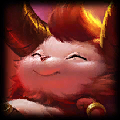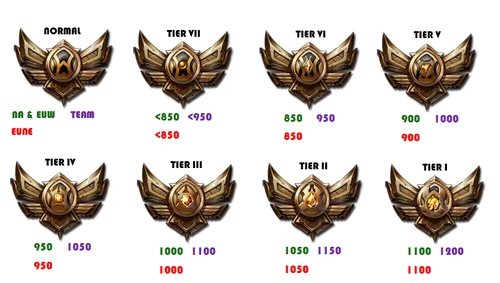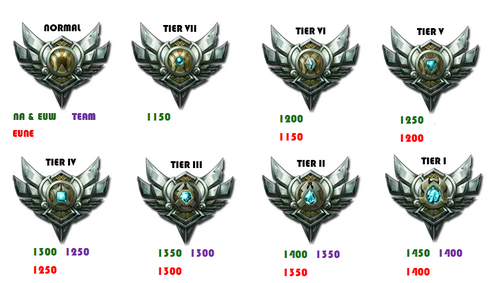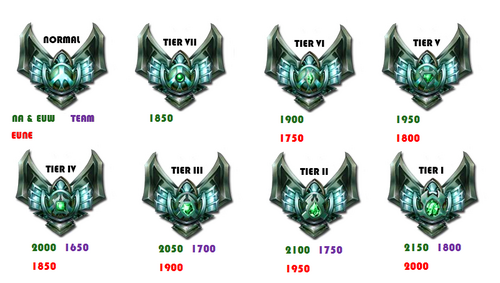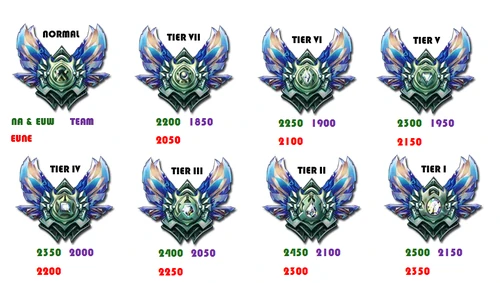The Elo rating system was used in League of Legends ranked games prior to Season Three when the League system was introduced.[1]
The Elo rating system is a method for calculating the relative skill levels of players, originally designed for two-player games such as chess. It is named after its creator Arpad Elo, a Hungarian American physics professor and chessplayer.[2] The Elo system was invented as an improved chess rating system, but today it has been adapted for use in many other games. Variations of it are also used as a rating system for multiplayer competition in a number of games and has been adapted to team sports including association football, American college football and basketball, and Major League Baseball.
In League of Legends, the Elo rating system was the first system used in order to match players of similar skill levels to play with/against. While Elo ratings applied to Normal game queues, the rating was, due to the nature of competitive games, of special significance in Ranked game queues.
- The Elo rating for Ranked queues was different for each type of queue: 5v5 solo, 3v3 arranged teams, and 5v5 arranged teams. The rating was only visible for ranked games after 5 games played in a certain Ranked queue. Players were awarded with medals in their summoner profile based on their Elo at the conclusion of the Ranked season. Medals were awarded as follows:[3]
- Bronze: Solo 5v5: Between 1250 and 1399 (Team 3v3: 1250–1409, Team 5v5: 1250–1409) (Top 25%)
- Silver: Solo 5v5: Between 1400 and 1519 (Team 3v3: 1410–1519, Team 5v5: 1410–1499) (Top 10%)
- Gold: Solo 5v5: Between 1520 and 1899 (Team 3v3: 1520–1699, Team 5v5: 1500–1749) (Top 3%)
- Platinum: Solo 5v5: 1900 and above (Team 3v3: 1700+, Team 5v5: 1750+) (Top 0.2%)
On September 11th, 2012, two months before the end of Season 2, the rating system was updated, which spread ratings out much further. This system introduced a new apex rank (Diamond) above Platinum, in order to provide very highly ranked players with a skill distinction and set them apart from other lower-ranked Platinum players. It also ranked players at the bottom of the Ranked ladder into one consolidated rating (Bronze VII). In addition, each rating became tiered, with one Medal tier being divided into seven smaller sections/tiers—represented by Roman numerals—with VII being the lowest and I being the highest. Each small tier was sectioned off every fifty Elo points (e.g. in Solo 5v5: 1150–1199 for Silver VII, 1200–1249 for Silver VI, etc.). In the 5v5 arranged teams queue, there were fewer sections than the 5v5 solo queue—Silver, Gold, and Platinum tiers only included sections IV through I—and the Bronze VII (lowest rating) to Bronze VI cutoff was 950 instead of 850.
- Players' rating was still visible only if they had at least 5 games played in a Ranked queue.
- Bronze VII: Between 0 and 849 (Team 5v5: 0–949) — Lowest Tier
- Bronze VI+: Solo 5v5: Between 850 and 1149 (Team 5v5: 950–1249)
- Silver: Solo 5v5: Between 1150 and 1499 (Team 5v5: 1250–1449) (Top 68%-13%) — Majority of Active Player Base
- Gold: Solo 5v5: Between 1500 and 1849 (Team 5v5: 1450–1649) (Top 13%-1.5%)
- Platinum: Solo 5v5: Between 1850 and 2199 (Team 5v5: 1650–1849) (Top 1.5%-0.1%)
- Diamond: Solo 5v5: 2200 and above (Team 5v5: 1850+) (Top 0.1%)
The listed rating distribution was established as shown for the North American (NA) and Europe West (EUW) servers. It differed in all other regional servers at the time based on Riot's internal assessment of each regional ladder's performance/standings.
Goals for Matchmaking[]
In essence, the Elo rating system is one way to assess skill level in a zero-sum game through math. This system compares two players' ratings to guess the game result—for example, "Player A will win vs Player B 75% of the time". Then the game is played. If a player wins, the player gains points, and if that player loses, they lose points. If the win was an outlier, meaning "unexpected" (i.e., the system expects that player to lose), the amount rewarded for that win is larger, and equivalently if the defeat was "unexpected" (i.e., the system expects that player to win), the amount lost for that defeat is larger.[4]
The system was modified for team use in League of Legends. Each team is assigned a "team Elo" based on its players' individual Elo: if one team wins, it is assumed that everyone on the team was "better" than the guess, and thus all team members gain points, and if that team loses, it is assumed everyone on the team was "worse" than the guess, and thus all team members lose points. If the win was an outlier/"unexpected", the team members gain more points, and equivalently if the defeat was "unexpected", the team members lose more points.
In addition to this basis, Riot uses various weights to adjust for a more deterministic approach, which assists the system with finding the right direction for Elo gains and losses based on each individual player's habits and performance. In terms of performance, various proprietary methods (which do not include counting score lines) are employed in order to identify players who are significantly more skilled than a new player—meaning they perform significantly better than "expected" in their current rating—and finally boost their rating. Additionally, Summoner level also boosts a player's Elo, as higher-level players have much more experience and than low-level players. In terms of habits, e.g. pre-made parties of players or a player returning after a long hiatus are factors that influence the determination of Elo rating.
It is normally expected for newer players to have larger fluctuations in Elo over their first number of games until the system has placed them at their appropriate skill level. This eventually results in rewarding good players for their consistency of performing better than the system expects, thus they keep gaining Elo until eventually they are either among the top players or the system is able to accurately guess that they will win and lose with equal probability.
Riot Zileas, one of the system's designers at the time, published a post detailing the implementation of the matchmaker used at the start of League of Legends' lifetime.[5]
Calculating Elo[]
The specific formulas which were used for Elo calculations in League of Legends are unknown. However, most Elo implementations share the same basics as that originally designed for chess. A brief summary is given below. For a more detailed discussion, see Wikipedia.
It is assumed that a person's performance varies from game to game in approximately a normal distribution and a person's Elo rating was the mean of that distribution. A person with a higher Elo may perform better on average than a player with a lower Elo, although usually it was mainly to do with the teamwork around that player. This score was determined entirely by win/loss statistics in relation to other players. For players A and B with respective Elo ratings of Ra and Rb the expected victorious outcome Ea of the game for player A was given by the following formula:
For every difference of 400 points, the team/player with the higher score is ten times as likely to win as the other team/player. This standard is for Chess and may have been different in League of Legends. After a game the actual outcome was compared to the expected outcome and each team/players rating is adjusted to bring them closer to where they should actually be. As a result, if a team was expected to win and does their score changes less than if they were expected to lose and instead won. Successive games would have eventually brought each player/team to a point where they were expected to win 50% of the time against opponents of equal score.
A player's change in rating was linear to the difference between the expected outcome and the actual outcome. It was given by the following formula where Sa is the result of the game and is presumably 1 for a win and 0 for a loss.
The magnitude of the score change was determined by the player's K value and other things, like a server crash (When the score you get is 50%). In chess initially this K value is big (25 for their first 30 games) resulting in large changes in Elo. This is so a player can rapidly find her or his correct place in the ranking system. As their number of wins and losses became more even this K value was reduced to prevent dramatic changes in Elo against evenly matched opponents (K = 15 to 7). This also prevented inflation in ratings at high Elo play. It appears that League of Legends used a similar system of changing K values: K appeared to be starting around 100, eventually leveling out to about 25.[6]
All players started ranked play with an Elo of 1200 for their first 10 games at level 30. From there they were assigned a score and changes are made as normal.[7]
Elo decay[]
Prior to the Season 2 rating system remake, Elo decayed over time when you were above 1400 Elo:[8]
- Elo decayed at a rate of 50 Elo for players in Diamond, 35 Elo for Platinum, 25 Elo for Gold, 10 Elo for Silver, and 0 Elo for Bronze for every 28 days of inactivity and once every 7 days thereafter.
- For Normal rating, inactivity was defined as no activity in any queue (Blind pick and Draft pick tracked together).
- For Ranked ratings, inactivity was defined as no activity in each specific queue (arranged teams 5v5, arranged teams 3v3, and solo 5v5 were all tracked separately), and decay only applied to players ranked 1400 Elo and above.
- The decay timer was reset and the player was deemed active again, after at least a single full game was played in the respective queue.
Trivia[]
- Elo gains were higher for the first ~50 games in a season for each queue (ranging from 50 down to 13).
- Duo-queuing never affected Elo gains/losses.
- A player's Elo rating was visible only after the first 5 games, but Elo placement required 10 games. Even today, 10 is still the required amount of games in order to finish Ranked placements, although rank is visible from the first one.
- The Chinese servers used the Elo Rating System up until the midst of Season Three, despite the League system having been released in all other servers earlier, at the start of the season. This was due to difficulties in proper implementation of the League system in their own version of the client.[9]
See also[]
References[]
- ↑ League of Legends Forums — Riot Yegg (15 January 2013), former Systems Designer New League System in Ranked. Retrieved 14 March 2020, 22:29:41 UTC by the Internet Archive.
- ↑ Elo rating system on Wikipedia
- ↑ Season One - Update on Rewards, Timeframe
- ↑ Wikipedia — Elo rating system
- ↑ League of Legends Forums — Riot Zileas (15 September 2009), former Vice President of Game Design LOL Matchmaking Explained (p. 1). Retrieved 9 March 2020, 23:24:16 UTC by the Internet Archive.
- ↑ Gaining very little Elo per game at Leagueoflegends.com
- ↑ Did starting Elo change? at Leagueoflegends.com
- ↑ Elo Decay Clarification
- ↑ Season 3: @Riot Please do something to china server | Posted 31 March 2013. Retrieved 31 December 2022.
